|
Paper 31
The Dances of Charles Wheatstone & Augustus Voigt
Contributed by Paul Cooper, Research Editor
[Published - 9th April 2018, Last Changed - 20th March 2023]
Charles Wheatstone was the proprietor of a Regency era music shop in central London, one of his major collaborators was the composer and harmonist Augustus Voigt; their joint publications offered some of the richest three-part melodies for Country Dance music that the publishing industry had ever known. In this paper we'll investigate their lives, and their contributions to that industry.
Charles Wheatstone (1768-1823)
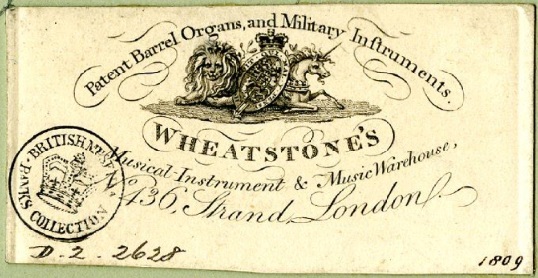
Figure 1. Business card for Wheatstone's Musical Instrument & Music Warehouse, c.1809. Courtesy of the British Museum.
Charles Wheatstone (Uncle of the more famous Sir Charles Wheatstone) ran a successful music shop in London from the end of the 18th Century through to his death in 1823. The origins of the firm are vague, the Exeter Working Papers in Book History track the existence of the firm back to at least 1791 at various temporary addresses in London; a further 1790 reference locates the business at Whitehall facing the Admiralty (The World, 18th June 1790). Wheatstone was not listed in Doane's 1794 Musical Directory, despite the nation's Principal Music Sellers being included; it's likely that his business was too small to be noteworthy at that early date, though the firm would go on to become one of London's major suppliers of music and musical instruments. Several members of Charles' family can be traced to Gloucestershire, including his brother John who was a solicitor in Dursley (near Gloucester), it's probable that Charles himself was originally from Gloucestershire and had set up business in London some time before 1790.
The earliest advertisements I know of for Wheatstone's Music Warehouse date from 1804 when he was located in Panton-street, Leicester-square (Morning Post, 16th January 1804), he sold The Court and Bath Dances, for the piano forte, as selected to be performed for the present year together with music composed by Pleyel, Haydn, Mozart, and others; he also sold Improved music paper, printed size; likewise an elegant sort for the pocket and Patent piano fortes, with additional keys, pedal, &c. . A few weeks later he advertised (Morning Post, 23rd February 1804) music for regimental bands, marches, quick steps, waltzes, and a wide selection of music by named composers and other assorted musical supplies.
A year later he had moved to a new and permanent address at 436 Strand (Morning Post, 14th March 1805, see Figure 2); by then he was selling music for dancing, musical games, and a wide variety of other musical supplies. The first reference to Augustus Voigt in Wheatstone's advertisements can be found in 1806 (Morning Post, 2nd May 1806) in which Voigt is credited as composing the flute accompaniment to the New Bath Dances, it would be the first of many such references.
Wheatstone's business churned out music for the following decade. In 1815 he partnered with Mr Dodd of Bath to establish The New Bath Musical Library. Subscribers paid a recurring fee, and in return could borrow musical books for a few days. A similar circulating library was also operated in London.
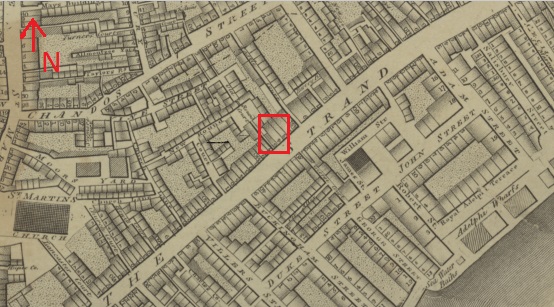
Figure 2. The location of the Wheatstone business at 436 The Strand, from the Horwood map of 1792-9. © THE BRITISH LIBRARY BOARD, HUS 050.
Wheatstone's name would appear in musical advertisements throughout the Regency period, though not without controversy. He was the defendant in several copyright disputes, including an 1815 action in which the musical publisher James Platts claimed that Wheatstone had republished his music in which the measure and music were preserved from the originals, but the bars and cadences varied in the most ingenious manner, with intent to evade the Act of Parliament (The Globe, 14th July 1815). It's entirely possible that Voigt was responsible for these ingenious modifications . Wheatstone experienced further such difficulties in 1818 when John Charles White of Bath accused him of pirating the tunes Rob Roy and Lady Caroline Morrison; this case was widely reported on in the press and was sister to a case we've investigated in a previous paper.
Wheatstone's musical publications remained known for their exceptional harmonies, many of which were composed by Voigt. Wheatstone produced at least nine volumes of a publication called The Harmonist consisting of Glees, Catches, Canons, Epigrams, &c. , at least 16 collections of Corri's Irish, Scotch, and Welsh Melodies, several books of Waltzes and Quadrilles, musical tutors, and so forth.
Wheatstone died in 1823. His brief obituary in the Morning Post (27th October, 1823) hardly does him justice: DIED - On the 23rd inst., aged 56, Mr Charles Wheatstone, of the Strand, Publisher and Music-seller . His Will is available through the National Archives. It reveals a close friendship with another music seller and ultimately his executor, Thomas Bolton of Soho; most of his estate was split between his nephews and nieces, but most notably between William and Charles Wheatstone (Junior) (later Sir Charles Wheatstone) who took over the business after their Uncle's death. The Wheatstone business continued to trade throughout the 19th Century and beyond. Charles Wheatstone (Junior) is understood to have been apprenticed to his Uncle in 1816; he went on to gain fame partly thanks to his own early investigations into the science of acoustics, and also as the inventor of the Concertina; he may have been influenced in this discipline (if only at first) by Voigt's own theories of harmony and musical science.
Augustus Voigt (c.1779-?)
Augustus Voigt (sometimes spelled Voight , especially in later publications) was a German composer who lived in London during the Regency period. He composed many popular tunes, but he was better known for being a harmonist; he could take an existing tune, add an accompaniment, and thereby improve the original work. It's in this capacity that he made most impact on London's social dancing industry of the early 19th Century.
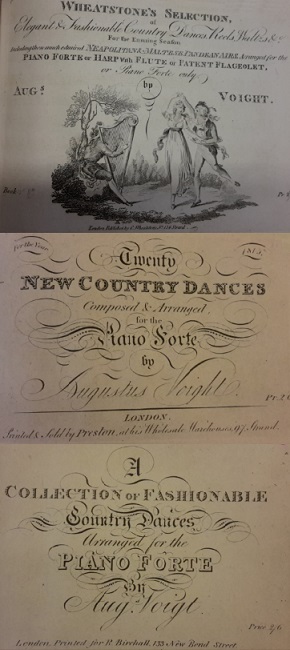
Figure 3. A Selection of dance collections with music arranged by Voigt, published in the 1810s by Wheatstone, Preston and Birchall respectively.
Much of what's known of his life comes from his biographic entry in the 1824 Dictionary of Musicians. He was born in Germany, and was said as a child to have been a musical prodigy. He found himself in London (almost by chance) in July 1803, just as the French took possession of Hanover. He decided to remain in London, and he needed work. At first he took on minor musical commissions, but as his genius became recognised his opportunities improved. In the words of the Dictionary of Musicians:
He has since resided in London, and has published, for a series of years, a vast variety of vocal and instrumental music, from symphonies to the simplest ballad. To conclude, the reader should bear in mind that the ability of a musical composer, thrown in the middle of a foreign metropolis to obtain a livelihood, should not be judged alone by the nature of the majority of his publications. It must be expected that a young man of genius, circumstanced as Voigt was on his arrival in this country, would devote the greater part of his time to such light compositions as were either ordered by the trade, or would be sure to bring a good price in the market.
The more serious parts of the music industry did not consider the early jobbing work of composers like Voigt to be worthy of notice; he was successful despite being associated with commercial activities. The first reference I've found to him in London described one of his musical arrangements (Morning Post, 26th August 1803) as being: by August Voigt, from the Continent . Another early reference is recorded courtesy of Henry Thompson in 1805 (Morning Post, 5th April 1805): Music - Mozart's Good Night, arranged as a glee with an accompaniment for the pianoforte, by Augustus Voigt; ... There has been a great enquiry for the beautiful ballads entitled The Lady in the Lobster, written by Rosa Matilda, composed by A. Voigt; ... likewise The Magic Harmonist, for one or two flutes, violins, or any other instruments of the compass, by A. Voigt; it composes, in whatever way arranged, an innumerable variety of the most beautiful and novel pieces . In both cases Voigt's name as the arranger of the music was as significant (if not more so) than that of the original composer.
His Magic Harmonist is an example of something that appears to have fascinated Voigt, he produced several Musical Game's during his time in London, we'll discuss them further below.
Voigt's L'Henre du Matin was reviewed in The Universal Magazine in 1806, their words are illustrative of the attention he was receiving: We have had occasion before to observe, that we are not in general admirers of Mr Voigt's compositions, it therefore affords us the more pleasure when we meet with a piece of this composer's, upon which we can bestow our unqualified praise; and such a piece is that now before us, it being entirety free from those cramped passages, and harsh transitions of key, which so frequently disfigure Mr V's performances. This duet is evidently written as a sequel to Von Esch's popular L'Heure de Minuit, but we feel no hesitation in giving it a decided preference to its precursor; the adagio movement with which it opens, is in a style truly grand and affecting; and the brillante with which it concludes, displays an originality and vividness of fancy, which we find only in the works of a master.
He began working with Wheatstone no later than 1806 (Morning Post, 2nd May 1806), but it was in 1807 (Morning Post, 7th October, see Figure 6) that it can be confirmed that they were publishing an important series of works together: Wheatstone's Selection of Elegant & Fashionable Country Dances, Reels, Waltzes, &c For the Ensuing Season, Including those much admired Neapolitan & Maltese Pandean Airs, Arranged for the Piano Forte or Harp, also Flute or Patent Flageolet, with an Accomp for the Piano Forte or Harp by Augs Voigt. At least 13 volumes of this publication were issued on an approximately annual basis, and Voigt's name was the most prominent on the cover. The tunes may have been sourced elsewhere, but Voigt made them interesting. He would typically provide two lines of accompaniment for each tune, resulting in three-part harmonies (see Figure 5) - even the best of their competitors tended only to sell two-part harmonies.
Voigt continued to work closely with Wheatstone over the following decade. His tunes also appeared in collections from many other publishers (see Figure 3), including Astor, Preston, Power and Birchall, but Wheatstone appears to have been his main distributor; Voigt's name was more prominently featured in Wheatstone's advertisements than in those of any other music seller (see Figure 8). Their relationship drifted to an end from around 1818, at which date Astor & Co appears to have taken over as the primary publisher of his work. Voigt's final (as far as I know) Wheatstonian publication dates to late 1818, perhaps hinting at a change in their relationship from around that date. Several further works were produced, but Voigt's connection with London appears to have come towards an end. He published his Musical Riddles for Winter Evenings in 1823, but I struggle to find references to him thereafter; there are hints that he may have returned to Germany, perhaps at (or shortly before) the date of Wheatstone's death. Further compositions by Voigt were issued in London after this date, including A Minuet of Four Different Characters described in 1831 as a minuet in two parts, which will play forwards, backwards, or upside down (The Atlas, 23rd October 1831); such later references are uncommon however.
The Dance Publications of Wheatstone & Voigt
Both Wheatstone and Voigt published numerous collections of Country Dances. Wheatstone, for example, produced at least 33 editions of his Occasional Repertory of Dances, &c. on loose sheets, each of which contained three or four pages of country dances with two lines of music (see Figure 4, right). These Wheatstone collections were broadly equivalent to those we've previously investigated by Button & Whitaker and Skillern & Challoner. The dates for these works are uncertain but they were probably published between about 1804 and 1814: the second number was published while Wheatstone was still located at Panton Street, presumably in 1804; the 7th number was advertised to be available in 1805 (Morning Chronicle, 12th November 1805); the 12th in 1806 (Morning Post, 29th December 1806) and the 19th in 1809 (Cheltenham Chronicle, 20th July 1809). I've only been able to study a handful of these collections, in most cases surviving copies have evaded my discovery (do get in touch if you have copies). Legal testimony from the 1815 Platts v Wheatstone copyright dispute dates the 33rd number to 1814, and suggests that Wheatstone only published around 150 to 200 copies of each of them; if that assertion is true (Wheatstone signed a declaration that it was, but it hardly seems credible to me), that would explain why so few copies are known to remain extant today - hardly any were produced in the first place.
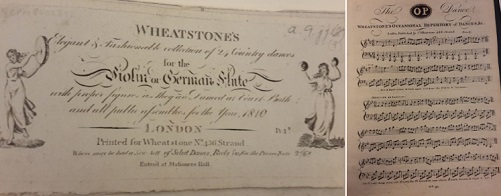
Figure 4. Wheatstone's Elegant & Fashionable collection of 24 Country Dances for the Year 1810 (left), and the c.1809 20th number of Wheatstone's Occasional Repertory of Dances &c. (right). Image © BRITISH LIBRARY BOARD, a.9.jj.(9.) and g.833.k., ALL RIGHTS RESERVED
Wheatstone also published a series of the ubiquitous (and comparatively cheap) 24 Country Dances for the Year .... dance collections (see Figure 4, left) in a similar style to those of many other music shops; his were issued between about the years 1809 and 1815. Two different works exist at the British Library that both have the cover for the year 1814; it's not clear why this would be. I've struggled to locate surviving copies of these collections.
Voigt and Wheatstone both published sporadic additional titles, two examples by Voigt can be seen in Figure 3; Wheatstone also issued a collection of Sixteen Favourite Country Dances in 1806 in an elegant format (they were advertised as The Master of the Ceremonies' Collection of Dances for 1806 , Morning Chronicle, 12th November 1805). A much later Wheatstone publication can be found in his 1820 No 1 of Spanish Dances, it's a rare example of a publication focussed on a new and briefly promoted Country Dancing variant known as Spanish Country Dances; this pseudo-exotic style of dancing involved the first couple in a longways set beginning improper (i.e. on the wrong side of the set), we've written about them elsewhere.
Aside: I was lucky enough to purchase a copy of Wheatstone's Spanish Dances a few years ago by mail-order; the vendor assured me that they were watermarked to date to 1850, but I knew that couldn't be correct, I could independently date them to around 1820. I bought them, received them through the post, then discovered... that the vendor was correct, the watermark really did show 1850! How odd. Then I found that I could turn the paper over, and upside down, and what had previously appeared to show 1850 transformed to show 1820! I discovered that the digits 1, 8, and 0 remain essentially unchanged when viewed from behind and upside down; but the digit 5 will become 2, and vice versa. This amused me.
The major collection of Country Dancing publications for which Voigt and Wheatstone are collectively known was a series of at least 13 works with the title Wheatstone's Selection of Elegant & Fashionable Country Dances, Reels, Waltzes, &c For the Ensuing Season, Including those much admired Neapolitan & Maltese Pandean Airs, Arranged for the Piano Forte or Harp, also Flute or Patent Flageolet, with an Accomp for the Piano Forte or Harp by Augs Voigt (see the image at the top of Figure 3). The term Pandean refers to the music of the Pandean Band, they were known for playing at the Vauxhall Gardens in London. It's this series of publication that the remainder of this paper will focus on.
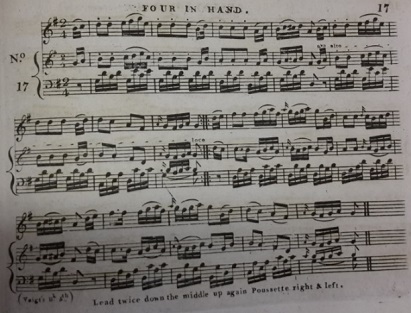
Figure 5. An example Country Dance from Voigt's c.1810 5th Book, featuring a three part musical arrangement. Image © VWML, EFDSS
Most of Wheatstone and Voigt's combined collections lack an explicit date on their covers, the few that do are (usually) the dates of later reissue rather than of the initial publication. Some success in dating the works can be achieved from reviewing Wheatstone's advertisements. This approach produces the following chronology: an edition (possibly the 1st, but I suspect actually the 2nd, see Figure 6) was advertised in late 1807 (Morning Post, 7th October 1807), the 4th in 1809 (The Courier, 30th September), the 5th in early 1811 (Morning Post, 25th January 1811, see Figure 8), the 6th in late 1811 (The Observer, 29th December 1811), the second edition of the 7th in late 1812 (Morning Chronicle, 25th December 1812), the third edition of the 8th in mid 1814 (Repository of Arts, May 1814), the 9th in late 1814 (Morning Post, 18th November 1814, see Figure 8), the 11th in late 1816 (The Observer, 10th November 1816), and the 13th in early 1819 (Morning Post, 16th February 1819, see Figure 8). This pattern represents approximately one publication a year, typically advertised from shortly before the end of the year, and remaining in stock (or reissued) for the following year. The date of the first number of the series remains uncertain, if we assume one work per year then that pushes it back to 1806; the 1807 advertisement (see Figure 6) doesn't mention an edition number, but it does emphasise the inclusion of Pandean Airs , something also emphasised within the contents of the second book; it seems reasonable to link the advert with the second book, and to guess that the first number was published a year earlier. This pattern results in the satisfying (and predictable) conclusion that a completely new work was issued each year; it also produces a sequence that is logically meaningful, the tunes that are named after historical events were issued within a year of that event occurring.
In some cases the surviving copies of their collections differ in their content. For example, later editions of the first book are slightly different to earlier editions. In several cases the cause can be tracked to legal complications; Wheatstone was accused of pirating music he had no permission to use, and the later editions would remove the problematic material. I hope to share more on this subject in a subsequent research paper.
Figure 5 shows an example Country Dance from their 1811 5th Book, the three separate lines of music are characteristic of Voigt's melodies. We've animated a reconstruction of it here. There are of course many ways that a historical dance can be reconstructed, it might even be argued that the published figures for this dance don't make much sense at all; the genius of the Wheatstone and Voigt collections is with the music, not the selection of figures that are attached to the music. Errors (or at least uncertainty) abound in their collections, but the music is rarely bettered in any other historical source. There are rare examples of three part harmonies for Country Dances being issued elsewhere at around this date; Thomas Budd issued some examples as did John Parry, but neither on the scale of Wheatstone and Voigt.
Some of the surviving Wheatstone publications indicate that they were sold by C. Mitchell, at his Musical Circulating Library & Instrument Warehouse (see, for example, the 4th book, where the Mitchell legend has been pasted over the Wheatstone original). It's unclear whether Mitchell was reselling Wheatstone's stock, perhaps on a sale-or-return basis; or perhaps Mitchell purchased Wheatstone's plates and produced new copies at a later date (presumably after Wheatstone's death in 1823). We've made a similar observation over the catalogue of Skillern & Challoner, some of their publications carried a Mitchell legend from around the same date.
The copies of the Wheatstone and Voigt publications that I've studied, from the 4th Book forwards, introduced Wheatstone's name at the top of the cover (his name was less visible with the earlier numbers). The later publications also added an etcetera symbol after Voigt's name, indicating that other composers were also involved in the production of these works; in some cases an h was also added to Voigt's name to make Voight . Most of the tunes were not originally composed by Voigt, but it's reasonable to assume that he composed the accompaniments to most of them.
An index of the Wheatstone and Voigt collections is available below.
Observations from the Wheatstone & Voigt Country Dance Collections
The musical scores from the Wheatstone and Voigt dance collections are of an abnormally high quality, and they selected many popular tunes to include in their books. Most of the tunes are known from other sources (sometimes of an earlier date), including those of Button & Whitaker and Skillern & Challoner amongst others. Wheatstone often published tunes that were already popular, he presumably aimed his books at the professional musicians who were likely to be called upon to play them.
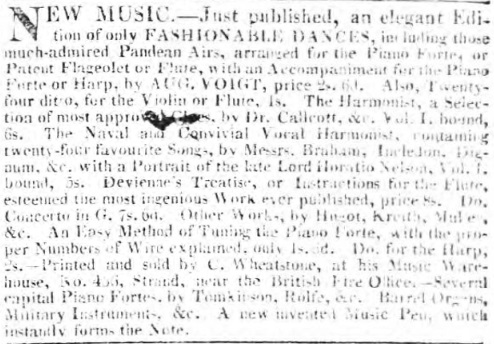
Figure 6. Wheatstone's advertisement for Voigt's Fashionable Dances, 1807. Morning Post, 7th October 1807. Image © THE BRITISH LIBRARY BOARD. ALL RIGHTS RESERVED. Image reproduced with kind permission of The British Newspaper Archive ( www.britishnewspaperarchive.co.uk).
The dancing figures attached to the tunes are of a lower quality. Having studied their work, I believe I can discern two phases to their production. The first spans their 1st through 10th books, and is characterised by relatively bland but appropriate for their date dancing figures; this range covers most of the series (c.1806 to c.1815). The second covers the 11th through 13th books, which are notably Wilsonian in nature (c.1816 to c.1818). The style changes fairly significantly between the 10th and 11th Books.
Beginning with the c.1816 11th Book we find Wheatstone making significant use of dancing figures associated with Thomas Wilson (Wilson was a high profile dancing master with strong and distinctive opinions on how Country Dance figures should be arranged). Terms such as Whole Pousette, Whole Figure Contrary Corners and Chain Figure Four suddenly appear in their collections from the 11th Book; this is terminology closely associated with Wilson, and notably different to that of the earlier volumes in the series. The later volumes also include Waltz Country Dancing terminology, as invented and promoted by Wilson from 1815. Such terms as Promenade 3 Cu al la Waltz and Whole Pousette with Sauteuse Step are featured; so too are some of the unique country dancing figures that Wilson personally (claimed to have) introduced.
I don't know why Wilsonian terminology features in these later collections, but the dances were not choreographed by Wilson himself (the internal timing is too inconsistent for a genuine Wilsonian publication). I suspect that from around 1816 Wheatstone began copying figure sequences directly from the rival firm of Button & Whitaker's legitimately Wilsonian publications; either that, or the Wheatstone choreographer was heavily but imperfectly influenced by Wilson. Wheatstone presumable sourced his figures somewhere else prior to 1816.
A curiosity of the c.1815 10th Book is that many of the tunes were printed without dancing figures. Occasional examples of tunes without figures can be found in their earlier books, but seven of the twenty tunes in the 10th book lack them. Many of the figureless tunes are waltzes, perhaps hinting that they were expected to be used for the waltz couple-dance. This collection also featured music for Vestris's Gavotte, an important stage dance that we've written about before.
Another curious dance can be found in their arrangement of Nathaniel Gow's tune Caller Herring in the c.1808 3rd Book. It's unusual as their arrangement includes a twelve bar strain of music, rather than the more normal eight or sixteen bar strains. Twelve bar strains are uncommon in historical Country Dancing, though not entirely unheard of (another example can be found in Thomas Wilson's 1818 The Equestrian). Their arrangement is also unusual in that it is annotated with the following statement May be played as a March or Dance , a clause not attached to any of the other tunes.
A further uncommon dance can be found in Wheatstone's arrangement of The Stop Waltz from the c.1816 11th Book. It's arranged with a peculiar allocation of bars to figures, with a deliberate pause in the middle. The Stop Waltz was a very popular waltzing tune at around this date, and it may well have featured the sudden pause when performed for waltzing couples; but it's unusual to find it arranged in this fashion for country dancing. The same technique is used rather more effectively in a dance called L'Alina from the same collection, and less compellingly in the Tripoli Dance, again from the same collection.
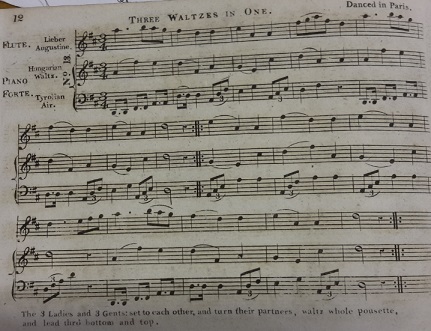
Figure 7. Three Waltzes in One, from the c.1817 12th Book. Image © VWML, EFDSS
A minor anomaly can be found in a tune called The Villagers Dance appearing in the c.1810 5th Book, then again as The Villagers in the c.1816 11th Book. The two tunes appear in a different key, with different repetition and figures, but it's the same basic tune.
The c.1817 12th Book includes a peculiar tune called Three Waltzes in One (see Figure 7), it involves three separate waltzing tunes being played concurrently over the top of each other. The tunes are named as Lieber Augustine , Hungarian Waltz and Tyrolian Air , the result is declared to be as Danced in Paris . The result is a plausible waltzing tune, though not the Waltz medley one might more generally expect to encounter!
The c.1817 12th Book includes a tune called Capt Wyke. It's unusual for two reasons; firstly, it happens so share a name with a tune that was the subject of extensive copyright litigation that we've written about before (in this instance it's only a coincidental matching of names, the tunes are different); and secondly, the tune is arranged either for a Country Dance or for a Quadrille (specifically for the L'Ete figures). It's uncommon to find a single tune arranged for both purposes, though several dance collections from around this date did include examples of this multi-purpose arrangement.
The c.1818 13th Book includes a tune called Rob Roy that was, unfortunately for Wheatstone, incorporated into the copyright challenges of the aforementioned Capt Wyke dispute. Wheatstone lost his case at court and was fined; this may be significant to the apparent absence of further Country Dancing publications - maybe he decided that publication was no longer worth the risk?
An observation that spans the entire collection is that the figures in the books are inconsistent with respect to their timing. Sometimes a figure will be adapted to a short strain of music, sometimes to a long strain; it can require ingenuity to make the figures fit the music at all. The inconsistency can leave the interpreter in doubt about what was intended, or indeed whether the Wheatstone choreographer really knew what they were doing at all! There are (or appear to be) mixtures of short and long leading figures from one dance to the next, unexpected repeat markers in the musical score, missing repeat markers where they might otherwise be expected, and so forth. Strain markers are absent in the dancing notation, so there's no clue to be derived from there. My impression is that Wheatstone (or his choreographer) simply borrowed figures from other publications, and printed them without much effort to see whether they matched the tune... whether they fitted the music or not seems to have been a matter of chance! For example, consider the unusually named Right & left or swing corners figure (which is discussed further below), I have circumstantial evidence that it was blindly copied from another publication, without consideration of what the term might mean. Nonetheless, most of the figures can be arranged or adapted to fit the music with a little effort; if we give Wheatstone the benefit of the doubt regarding the compatibility of his figures and music, then there are but a very few that are beyond reasonable comprehension. It's a somewhat sad indictment of the entire Country Dancing industry at this date that the same observation might be made for most collections from most publishers; it has been my experiece that not many of the music shops produced consistently high quality combinations of tunes and figures.
Unusual Figures from the Wheatstone & Voigt Country Dance Collections
We've arranged versions of most of the dances from the Wheatstone and Voigt repertoire, and in so doing noted a few comment worthy figures. Some of the more interesting include:
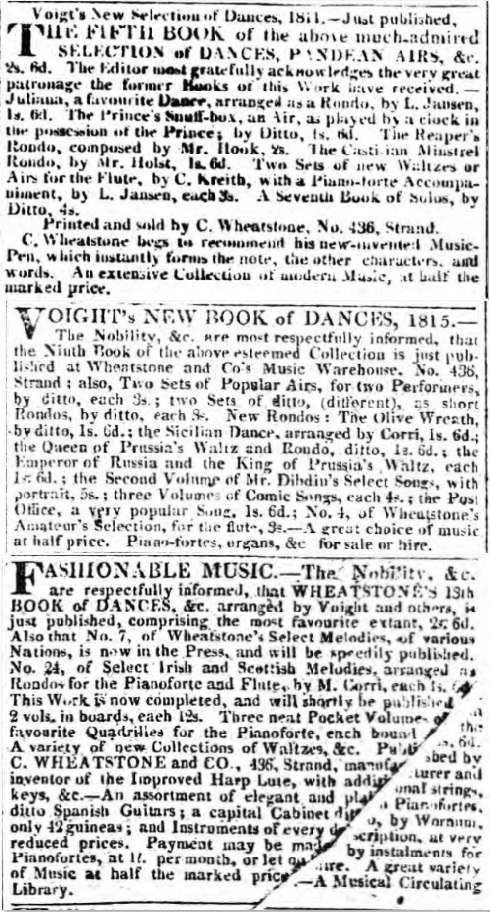
Figure 8. Advertisements for Voigt's 5th, 9th and 13th books. Above: Morning Post, 25th Jan 1811; Middle: Morning Post, 18th November 1814; Below: Morning Post, 16th February 1819. Images © THE BRITISH LIBRARY BOARD. ALL RIGHTS RESERVED. Images reproduced with kind permission of The British Newspaper Archive ( www.britishnewspaperarchive.co.uk).
- Hands three round and back again (The Colliggi, c.1806 1st Book). The more typical variant of this figure involves the first couple setting, then hands three with the second lady, then setting then hands three with the second man; a less common variant is simply hands three with the second lady then with the second man. The Wheatstone figure has the
and back again instruction, which is rather odd; it's probably intended to imply and the contrary figure (that is, hands-three with the second lady, then with the second man), but if taken literally it's a circle once around and then back again. We've animated it in this literal form (because variety is fun), but I suspect a more common figure was probably intended.
- The 1st Lady lead into the 2d Cus place, the Gent follow (Off she goes, c.1806 1st Book). I'm not entirely sure what to make of this figure; the
follow instruction implies a variant of the chase or hunt figure, though it's expressed in unusual terms. The music is even more peculiar, it's printed in 12/8 time signature. Such figures are uncommon in early 19th century country dances, and the use of the word lead adds further confusion. It has been animated as a chase figure, but a variant of the down-the-middle leading figure may have been intended.
- Lead twice down the middle and up again (Paddy O Rafferty, c.1806 1st Book, see also Figure 5). This figure can be found in several historical Country Dances, so it's not all that rare; unfortunately the meaning is not clear. In this example it's a progressive figure; it could imply
lead twice as far down as normal, then back to progressed places , or 1st Couple lead down, and back, then down a second time, and back (asymmetrically progressive on one iteration but not the other), or even the first couple lead down and back (progressive), then the second couple lead down and back (non progressive) . It might even be used as evidence for a double progression country dance, something that can conveniently be arranged for a modern three-couple-set formation. An alternative non-progressive reconstruction of the same figure can be found in Four In Hand from the c.1810 5th Book.
It's perhaps worth noting that James Platts (in, for example, his 1797 Hubble Bubble) offered a more detailed description of potentially the same figure. He wrote Lead down the Middle 2 Cu & up again, Lead down the Middle 2 Cu & up one . Platts used it as an asymmetric figure, though one could still argue that there's an implicit cast in the first iteration resulting in a double progression. His variant probably involved returning to places in the first half of the figure.
- Foot it outsides, with your partner (Paddy O Rafferty, c.1806 1st Book). This is another odd combination of terms; the phrase
with your partner hints at a variation of a lead outsides figure, but one that involves the active couple moving together and setting. It could be a variant of the Wilsonian Foot in the Centre figure, but perhaps facing outwards; though that doesn't seem consistent with the with your partner instruction. It has been animated as a variant of the gallopy style of lead outsides , but other reconstructions are clearly possible.
- Cast off 3 Cu & back again (The Spanish Patriots, c.1808 3rd Book). A
cast off 2 Cu & back again figure is quite common in country dances of this period, it's described by Wilson here. The Wheatstone instruction clearly calls for a cast off of three couples; if taken literally, this may require extra dancers in each minor set simply to act as pillars for the leading couple to cast around. The instruction may be a mis-print as the more common figure, or perhaps the choreographer intended a promenade figure to be understood, or perhaps the Wilsonian The Top Couple Casts Off, the Second and Third Couples Follow . It has been animated as written.
- Cast off out sides (Voulez Vous Dancer Mademoiselle, 1811 6th Book). This instruction might be equivalent to
cast off 2 couple as previously described, or perhaps to the Wilsonian The Top Couple Casts Off, the Second and Third Couples Follow , or perhaps something else again.
- Pousette 2 Couple (I'll Go No More to Yon Town, or The Princes Favorite, c.1810 5th Book). This figure appears with the first couple already progressed, so it might be a pousette at the top then a second pousette at the bottom; or it might be a regular pousette once around with the second couple. It has been animated as a pousette at top, and then at bottom.
- Pousette 3 Couple (The Prime of Life, c.1808 3rd Book). This is an unusual figure name, it appears in a choreography that also features
Cast off 3 Cu , it might imply a pousette at top and then again at the bottom, or a pousette with the third couple, or even be a misprint for the term Promenade . It has been animated as a pousette at top, and then at bottom.
- Fall into opposite places, sett 3 & 3, fall into proper places, sett again (La Terza, c.1810 5th Book). This figure follows a
turn with both hands figure, and results in an unusual variant of the set three & three figure; it would normally be danced at top-and-bottom and then at the sides, but these instructions clearly call for the dancers to fall into opposite places in order to set. The entire combination of tune and figures in La Terza is quite unusual; the time signature changes from 2/4 to 6/8 time part way through, and the figures are more explicitly Wilsonian in their timing and selection than in other Wheatstonian dances of this date (e.g. it includes the figures set & change sides and down Mid 2 Cu up 1 ). La Terza is an especially interesting dance that we've written about before.
- The 1st Lady falls in between the 2d and 3d Gent, the 1st Gent between the 2d and 3d Ladies (The Muses, c.1812 7th Book). This figure almost seems to be another variant of
lead outsides , except that the dancers are explicitly instructed not to lead out at the sides and to instead fall into lines. The figure appears to be non-progressive from context, so it has been interpreted as being similar to Thomas Wilson's The Lady Sets Between the Two Gentlemen, and the Gentlemen Between the Two Ladies , but with a return home afterwards.
- Right & left or swing corners (The Maid of Seville, c.1812 7th Book). The mystery involves the word
or ; it's unclear whether Wheatstone intended a logical alternative in the sense of either X or Y but not both , or as an alias in the sense of X also known as Y , or some other meaning. Either interpretation would be highly uncommon. The figure sequences printed with Country Dances were usually intended as suggestions, dancers were welcome to arrange their own figures; the logical meaning is therefore improbable, especially as further alternative figures are absent from the remainder of the collection. The implications of an alias are more interesting, perhaps right & left was sometimes used as a synonym for Swing Corners ? It would make sense as a synonym, there are several common interpretations of the term Swing Corners , but they all typically involve swinging first with the right hand, and then with the left, then again with the right hand, and again with the left. We're written more on this subject here and here.
We've suggested (above) the idea that Wheatstone may have borrowed figures from collections by other publishers (without acknowledgement), I suspect that has happened with this figure; it's notable that this same highly unusual figure sequence for The Maid of Seville can be found verbatim in an earlier Skillern & Challoner dance called Lord Nelson's Victory from their c.1806 second collection. This was almost certainly Wheatstone's immediate source for the figure (it's improbable that this otherwise unique figure sequence should appear in both publications by pure chance, it's more readily believable that Wheatstone copied the figure sequence without comprehending the significance of what he was doing). The only significant difference between the two figure sequences is that the Skillern & Challoner variant has the controversial figure as right and left (or swing corners) .
Wheatstone's Quadrilles
As far as can be discerned, Wheatstone ceased the publication of Country Dance collections in or around 1818. I can only speculate at a reason for that change: he may have been weary of copyright disputes, perhaps his arrangements with Voigt had terminated, perhaps he was reacting to market demand. What can be shown is that the Quadrille dance was becoming popular in London from around 1816, had achieved a degree of ubiquity by 1818, and that the venerable Country Dance was becoming less popular; Wheatstone published Quadrille collections from around 1817. He wasn't the only publisher to shift focus at around this date, we've seen (for example) the same pattern amongst the dance publications of Skillern & Challoner; the publishing industry was evolving.

Figure 9. Quadrille dancers, from Wheatstone's Quadrilliana, c.1823. Image © BRITISH LIBRARY BOARD, e.41.g., ALL RIGHTS RESERVED
Wheatstonian Quadrilles were available for purchase from mid 1817. An 1817 Wheatstonian advertisement (Morning Post, 27th May 1817) read: Just published, a selection of the most elegant Quadrilles extant, as danced at the Argyle Rooms, Almack's, &c. with preliminary remarks. Figures and technical terms explained in English, printed in a neat pocket size, and bound, at only 4s6d. A selection of ditto, different, for the flute, the same size, 4s. . A further advertisement (Morning Post, 16th February 1819, see Figure 8) mentioned the availability of Three neat Pocket Volumes of the favourite Quadrilles for the Pianoforte, each bound, 4s6d. . The later references presumably includes the two earlier publications, plus a third produced during 1818. I have studied three such Wheatstonian volumes, presumably those referred to in the advert, and they're rather interesting. Two are marked as Volume 1 , the other has no volume number evident at all; the publication sequence of the works is therefore unclear, and their identification as the works from the advert remains uncertain. Their contents are appropriate for an 1817 to 1819 date however, so I suspect they are the advertised works.
One (I'll refer to it as the Volume 1 as the content appears to be the earliest and matches the 1817 advert) of these three volumes is available for study on the web courtesy of the University of Toronto. It's a fascinating work. It consists of the figures and music for Edward Payne's first four sets of Quadrilles, together with explanatory text and a dictionary of terminology. I've studied two different copies of this same publication (one from Toronto and one from New York, see Figure 10), each of which has mildly differing content; the Toronto copy is the richer, and presumably later variant. Both were published in London, neither are explicitly dated. The VWML have a coverless copy of the NYPL version.
There is however a hint of mystery; the quadrilles within this little Preceptor are the first four sets published by Edward Payne in (or no later than) the year 1816. Payne's quadrilles were popular, but those of his rival James Paine were even more popular by 1817. The Wheatstone publication includes a short introductory passage of text, the authorship of which is uncertain, but the quality of which is relatively high. So who provided that text, and why focus on Payne's Quadrilles, and why produce new printing plates at some point after initial publication? I have a theory. I suspect that Wheatstone republished a work originally published by (or for) Edward Payne himself back in 1816: Payne's otherwise lost Quadrille Instructor. Several advertisement's for Payne's Instructor do exist (see, for example, Figure 11), the contents are therefore known to have been his first four Quadrille sets; the accompanying text from the Wheatstone volume is consistent with what might be expected for an 1816 Payne publication. The evidence for the theory is entirely circumstantial, but it seems reasonable; I've read two of Payne's other books, and while there's nothing in them to suggest the Wheatstone work is by the same author, there's nothing to disprove the theory either, and there are some hints of similarity. I suspect Wheatstone either partnered with Payne in the publication of the Quadrille Instructor, or copied from Payne. Payne died either in late 1818 or early 1819; so even if he disapproved of what Wheatstone had done, he was in no position to block the ongoing publication from 1819. My theory is that Wheatstone initially reissued Payne's publication with a new cover (and cheaper price) over the existing content; but as the printed stock of Payne's book was exhausted, he produced fresh plates with the minor changes evident in the Toronto version of the book, presumably after Payne's death. Provenance confusion aside, the contents of this volume are relevant to London's Quadrille dancing of 1816, and are largely derived from the work of Edward Payne (focussing as they do on Payne's first four sets of Quadrilles), regardless of who authored the accompanying text. If you have an original copy of Payne's Quadrille Instructor, do get in touch... I'd love to know more!
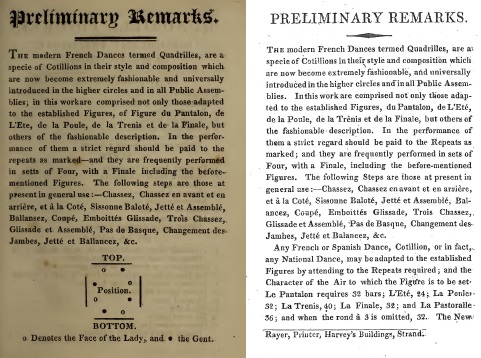
Figure 10. Preliminary remarks from two copies of Volume 1; the edition on the left is courtesy of the University of Toronto, the right is from the NYPL.
The other two Wheatstonian miniature Quadrille collections are almost as interesting as the first. One, we'll call it Volume 2 contains 43 dance tunes (mostly Quadrilles, though with other tunes interspersed) without figures, and the other (Volume 3 ) contains the tunes and figures for 39 Quadrilles of unknown provenance (I can't identify them). A few of the tunes in the second work can be identified, including some Waltzes previously published by Edward Payne, but most are of similarly unknown provenance. Unlike the first of the three collections, these presumably later volumes appear to have been new works; they are likely to have been the creations of an enthusiastic but otherwise unknown Quadrilleer. They're somewhat reminiscent of the similarly high quality but under appreciated Quadrille Sets published by John Charles White and Thomas Wilson at around the same date.
Wheatstone went on to publish at least three further significant collections of Quadrilles. The next (possibly, the date is uncertain) was Six Sets of Favorite Quadrilles Composed & Arranged for the Piano Forte ... By Joseph Collins, Professor of Music, The Figures by Monsr Hamlin. I've struggled to find a reliable date for this publications, but it appears to have been issued c.1820. I have no further information about either Collins or Hamlin, the Quadrilles themselves are nice enough but seem not to have excited the public (they're not known from other sources). It's possible, though entirely speculative, that Collins and Hamlin were Wheatstone's collaborators for the earlier Quadrille publications.
A more significant collection of Quadrilles was published c.1822 in collaboration with F. Simonet. This set were titled Fashionable Parisian Quadrilles, Performed by the Bands of Michau, Musard and Collinet. The final Quadrille in the set references Weber's Der Freischütz, which helps to establish the publication date as being 1821 or later. Simonet had a genuine claim to significance; he was one of the celebrity band leaders who performed at Almack's Assembly Rooms, and elsewhere in fashionable London - it's likely that his Quadrilles were danced by London's fashionable elite. The term Parisian in the title probably implies the Quadrilles danced at Almack's (rather than literally from Paris ); the Band of Michau, Musard and Collinet regularly performed there. This band gained great fame throughout Britain, the band's leaders may well have brought Quadrilles to Almacks with them from Paris, but they often composed their own and published a great many Quadrilles in London throughout the 1820s. A copy of this book is available through Google Books, courtesy of the British Library.

Figure 11. Payne's Quadrille Instructor ( Morning Post, 21st September 1816). Image © THE BRITISH LIBRARY BOARD. ALL RIGHTS RESERVED. Image reproduced with kind permission of The British Newspaper Archive ( www.britishnewspaperarchive.co.uk).
A further publication of Quadrille music, without figures, was issued c.1823 (the copy at the British Library is printed on paper watermarked for 1823, the same year in which Wheatstone died). This work was called the Quadrilliana, it drew extensively from the Quadrilles of both Edward Payne and James Paine, together with a few others from Joseph Hart, F. Simonet, and others. The provenance of the tunes wasn't indicated in the book, but most can be identified with a little effort. Each tune is presented with just the treble score, there are no accompaniments. Most of the 47 tunes were genuinely popular, so it was probably a useful publication for amateur musicians to enjoy playing from. It could of course have been published after 1823 and have been issued by Wheatstone's successors; but there's little evidence of his nephews publishing social dances, I suspect this work was issued (or at least prepared for publication) during Wheatstone's lifetime. It's probably the last such work that he published.
Wheatstone's quadrille publications seem not to have been especially important; they're fascinating from a modern perspective, but London's more fashionable consumers bought their Quadrilles in ordinal sets issued by celebrity band leaders and dancing masters: Payne, Paine, Musard, Hart, Chivers, &c.. Wheatstone's Quadrilles may not have been widely known, but he appears to have been one of the more plentiful suppliers of Quadrille dances in Regency London.
Musical Games
Wheatstone and Voigt made a formidable team, and in one rather unusual respect they seem to have been well paired - they both enjoyed musical puzzles. Or perhaps more accurately, they both either created or published them. For example, consider Voigt's 1818 Musical Charade Waltz as advertised in Figure 12; the associated riddle reads: My first to numbers gives increase, My next comes on when youth shall cease; And if to numbers you're inclin'd, The first five notes my whole will find . The answer (look away now if you don't want to know) is found in the first five notes of the associated waltz tune... A.D.A.G.E.

Figure 12. A Musical Riddle, Morning Post, 19th June 1818. Image © THE BRITISH LIBRARY BOARD. ALL RIGHTS RESERVED. Image reproduced with kind permission of The British Newspaper Archive ( www.britishnewspaperarchive.co.uk).
Voigt published a collection of Musical Riddles; A Collection of Enigmas, the words by Lord Byron, Horace Walpole, Dean Swift and others in 1822; he took riddles and set them as lyrics to music. It consisted of 36 enigmas, each of which were arranged as the words of a song to which he'd composed the music; for example:
Pray tell me Ladies if you can,
Who is that highly favourd man,
Who tho he marry many a wife,
May still live single all his life?
The answer was of course a clergyman. Adapting the riddle to music and presenting it as a song was unusual, it seems to have been something of a speciality for Voigt.
Another of Voigt's projects involved publication of The Mathematical Index in 1819 (Morning Post, 23rd March 1819), it was described as A simple and comprehensive method of acquiring a thorough knowledge of major and minor scales, keys, intervals &c.. Composed expressly to relieve the arduous duties of the profession in the instruction of young students . The contents of this work are a little beyond my comprehension, but it was supposed to help students with musical theory. Wheatstone's nephew and successor, the later Sir Charles Wheatstone, became famous for his theories of resonance; I suspect the young Charles may have enjoyed discussing ideas with his Uncle's friend. That said, this interesting phase of Voigt's career seems to have taken off after co-production with Wheatstone ceased.

Figure 13. Musical Game, Morning Post, 26th February 1805. Image © THE BRITISH LIBRARY BOARD. ALL RIGHTS RESERVED. Image reproduced with kind permission of The British Newspaper Archive ( www.britishnewspaperarchive.co.uk).
Voigt appears to have had a fondness for games ever since arriving in England. Several advertisements were published in 1805 for Voigt's Musical Game (e.g. Figure 13); it was probably a system for constructing (I hardly dare write composing ) musical scores, perhaps through the use of dice or some other system of chance. I've failed to find a surviving copy to study. A second edition was advertised in 1806 (Morning Post, 2nd May 1806).
By late 1808 Wheatstone began advertising availability of his own New Christmas Gift, or Musical Game; for the improvement and amusement of juvenile Amateurs (The Star, 23rd December 1808); it's unclear whether Wheatstone's game was related to Voigt's, but it seems circumstantially probable that it was. They were certainly working together by that date. Wheatstone also advertised his New Invented Music Pens from around 1809 (The Observer, 8th January 1809), though I can't determine quite what these pens were. I have studied Wheatstone's game however, it involved using random numbers to construct a tune; it's closely derived from the earlier games published in Germany by Simrock (a c.1796 example is available through Google Books here; the music is credited, somewhat dubiously, to Mozart). It's tempting to imagine that Voigt brought such a game to London with him, adapted it to his own purposes, and arranged to sell it. By 1810 Wheatstone's game was being advertised as a new Musical Game, by the late celebrated Mozart (Morning Post, 4th January 1810), it was presumably the same game from 1808, derived from a German source.
In late 1811 Wheatstone began advertising just published, Two Musical Games, or Dominos, designed for Juvenile Instruction and Amusement (The Observer, 29th December 1811); one of which may have been the earlier musical game, or they may perhaps be the games subsequently described in 1823 as Jones's Musical Game, for establishing in the mind the varieties of time; Piele's Musical Game, for teaching the names of the notes in the treble and bass clefs (Belle Assemblee, 1823). The equivalent advert in 1812 added an extra detail: These Games impress on the memory the most useful branch of the science, which is too frequently neglected in the tuition of young persons (Morning Chronicle, 25th December 1812). Indeed, they were still being advertised by Wheatstone as new as late as 1820 (Morning Post, 21st December 1820).
These games were not particularly important, but they do demonstrate a sense of fun; and perhaps also a commercial insight into what could sell.
An index of the Country Dancing Publications of Wheatstone & Voigt
The following table lists the Country Dancing publications known to have been jointly issued together by Wheatstone and Voigt. In some cases there were multiple editions of a book published, the table includes the variant editions where known. At the time of writing there are no copies of these works known to be available to view on the internet, if you're lucky enough to own copies, do please consider sharing them with the community of enthusiasts who enjoy recreating these dances. If you'd like assistance in doing that, do Contact Us, we'd be happy to help.
| Work & Date | Image | Comments |
A Selection of Elegant & Fashionable Country Dances, Reels, Waltz's &c. Book 1st
c.1806, c.1808, c.1810 |
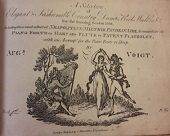
|
Two copies of this work exist at the British Library, their contents are very different. Further variants may also exist; it seems that Wheatstone published or republished this work (under the same cover page) several times before it reached its final state. Both of the copies that I've studied are likely to date to 1808 or later and neither may be the first work published under this shared title. I suspect that an original work might have been published around the year 1806 and that it was reissued several times with modifications thereafter.
One of the tunes (La Belle Laitiere) from an earlier version of this work was involved in a copyright dispute in 1812 with the music publisher Robert Birchall, we've investigated that dispute elsewhere; it's possible that one or more of the later editions may have been produced in order to satisfy a legal obligation to remove copyrighted material from the work.
Of the two copies that I've studied one is clearly earlier than the other; the earlier edition was printed with two lines of music for each tune whereas the later edition had three (a convention that was continued for the rest of the series). Many of the tunes are the same across both editions but the printing plates were evidently remade at some point.
The contents of the earlier edition (c.1806-1808) are: Lord Cathcart's welcome to Scotland, Caro Dolce, The Mazy Dance, The Surry Yeomanry, The Nameless, Miss Gayton's Hornpipe, Countess of Moira's Lilt, La Belle Laitiere, Harlequin's Hornpipe, The Colliggi, Murphy Delarney (N.B. When there is no Flageolet The player must leave out the middle Part), St Kilidas's Reel, Lady Caroline Lee's Waltz, Off she goes, Athole House, Lady Harriot Cavendish's Trip, Paddy O Rafferty, Lady Charlotte Bentinck's Reel, Lady Ann Stewart's Strathspey, Follow her over the border, Lady Montgomery, Lady Mary Douglas's Reel, Ross Common, O'er the Boggie with my Love, Lock Errock Side.
The contents of the later edition (c.1810-1812 perhaps) are:
Lord Cathcart, New Claret, Miss Gayton's Hornpipe, Lady Montgomery, St Patrick's Day, Lady Mary Douglas, O'er The Bogie, Ross Common, St Kildas's Reel, Caro Dolce, Lady Caroline Lee, or the Glos'ter Waltz, The Triumph, Lady Hamilton's New Walt, Follow Her Over The Border, The Hungarian or Shaw's Waltz, Honey Moon, The Mazy Dance, Countess of Moira's Lilt, Miss Millet, Lady Cholmondley's Waltz.
Full Title: A Selection of Elegant & Fashionable Country Dances, Reels, Waltz's &c. For the Ensuing Season. Including those much admired Neapolitan & Maltese Pandean Airs, Arranged for the Piano Forte or Harp also Flute or Patent Flageolet, with an Accompt for the Piano Forte or Harp, by Augs Voigt. Book 1st. Price 2s/6
Image © THE BRITISH LIBRARY BOARD, b.64. ALL RIGHTS RESERVED
|
A Selection of Elegant & Fashionable Country Dances, Reels, Waltz's &c. Book 2d
c.1807 |
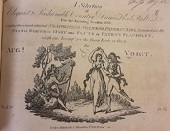
|
Some copies of this work include a notice on the second page which indicates Two additional fashionable DANCES for the 10th EDITION ; the two bonus dances were the first two in the list below; earlier editions began with Tekeli.
The contents are: The Gallop, The Shaddie or Miss Ray, Tekeli (Each Part of every Dance may be repeated an Octave higher on the Flute or Piano Forte ad libitum), Fairy Dance, The Labyrinth (A Pandean Air), Pandean Dance in Tekeli, Madam Catalani's Favorite (A Pandean Air, the 2d time an Octave higher ad libitum), The Tars of the Victory, The King of the Cattie, Lady Milton's Favorite (A Pandean Air), Ap Shenkin, A Neapolitan Air, Johnny Pringle, The Ridicule, Maltese Dance, La Romenella (Trio), Dance in the Forty Thieves, The Rope Dancer, Andrew Carey, St Augustine, Mr C Kemble's Waltz.
Full Title: A Selection of Elegant & Fashionable Country Dances, Reels, Waltz's &c. For the Ensuing Season. Including those much admired Neapolitan & Maltese Pandean Airs, Arranged for the Piano Forte or Harp also Flute or Patent Flageolet, with an Accompt for the Piano Forte or Harp, by Augs Voigt. Book 2d. Price 2s/6
Image © THE BRITISH LIBRARY BOARD, b.64. ALL RIGHTS RESERVED
|
A Selection of Elegant & Fashionable Country Dances, Reels, Waltz's &c. Book 3d
c.1808 |
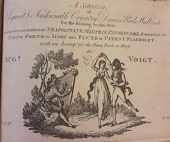
|
The British Library have two copies of this work, the contents of which (as seen with the first volume) are different.
The contents of (what appears to be) the earlier edition are: The Runaway, Noel Park, Major Spicer, La Deliberation (A Pandean Dance), The Marchioness of Tavistock's Waltz, Prince Dolgorucki, Time's A Tell Tale, Morgiana (A Pandean Air), The Spanish Patriots, The Africans, Mr King's Waltz (The Master of the Ceremonies at Bath & Cheltenm), Madam Catalani's Waltz, The Prime of Life, The Graces, Vauxhall Saloon (A Pandean Dance), Mr Forth's Waltz (Master of the Ceremonies at Brighton), The Dutchess of Bedford's Waltz, Miss Bristow's Favorite Pas Seul, Caller Herring (May be played as a March or Dance), The Fairy Prince, Capper Fey.
The contents of (what appears to be) the later edition are:
Morgiana,
Noel Park
Miss Spicer,
The Dutchess of Bedford's Waltz,
The Marchioness of Tavistock's Waltz,
Prince Dolgorucki,
Time's A Tell Tale,
The Mantle (A Pandean Air),
The Spanish Patriots,
The Africans,
Mr King's Waltz (The Master of the Ceremonies at Bath & Cheltenm),
Madam Catalani's Waltz,
The Prime of Life,
The Runaway,
Vauxhall Saloon (A Pandean Dance),
Mr Forth's Waltz (Master of the Ceremonies at Brighton),
La Deliberation,
The Gallop,
Caller Herring (May be played as a March or Dance),
The Fairy Prince,
The Shaddie or Miss Ray.
Full Title: A Selection of Elegant & Fashionable Country Dances, Reels, Waltz's &c. For the Ensuing Season. Including those much admired Neapolitan & Maltese Pandean Airs, Arranged for the Piano Forte or Harp also Flute or Patent Flageolet, with an Accompt for the Piano Forte or Harp, by Augs Voigt. Book 3d. Price 2s/6
Image © THE BRITISH LIBRARY BOARD, b.64. ALL RIGHTS RESERVED
|
Wheatstone's Selection, of Elegant & Fashionable Country Dances, Reels, Waltz's &c. Book 4th
1809 |
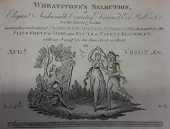
|
An advert in the Morning Post, 15th May 1810, once again hints at bonus content in a later edition; it reports that: the celebrated Persian Dance and Colonel Taylor's Waltz are added to the 10th edition of Wheatstone's Selection, arranged by Voigt, &c. . The two surviving copies of this work that I've studied both have those two dances in 1st and 4th position, with the remainder tunes numbered normally throughout. The bonus dances don't have the appearance of having been added later (as was clearly the case in the 2nd Book), so it's not clear whether they genuinely were new.
The contents are: The Persian Dance, Montreal, The Russian Dance, Coll Taylor's Waltz, Morgiana in Ireland, The Stralsund Waltz, Michael Wiggins, Henly Park, The New Brighton Waltz, The Calabria, Crop the Croppies, The Circassian Bride, The Tyrolese Waltz, The Morning Star, The Gypsey Dance, The Italian Momfrena, The Sicilian Waltz (Pandean), The Self, The Jubilee Dance, The New Spanish Waltz.
Full Title: Wheatstone's Selection, of Elegant & Fashionable Country Dances, Reels, Waltz's &c. For the Ensuing Season. Including those much admired Neapolitan & Maltese Pandean Airs, Arranged for the Piano Forte or Harp also Flute or Patent Flageolet, with an Accompt for the Piano Forte or Harp, by Augs Voigt. &c. Book 4th. Price 2s/6
Image © VWML, EFDSS
|
Wheatstone's Selection, of Elegant & Fashionable Country Dances, Reels, Waltz's &c. Book 5th
c.1810 |
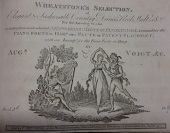
|
The contents are: Juliana, La Terza, Morgiana in Spain, Mrs Billingcroft's Waltz, The Honble Miss Courtney (Danced at the Bath Rooms), Michael Wiggins in Ireland, The Villagers Dance, I'll Go No More To Yon Town, Or The Princes Favorite, Lady Mary, The Lads of Ayr, The Princes Snuff Box (Play'd by Clock Work in the Possession of H.R.H. P. of Wales), Lord Wellington, Talavera, Morgiana in Scotland, Spanish Dance (The Celebrated Bollero), Gustavus (A Pandean Air), Four in Hand, Scotch Jubilee Dance, The Barbara, Verona (A Pandean Air).
Full Title: Wheatstone's Selection, of Elegant & Fashionable Country Dances, Reels, Waltz's &c. For the Ensuing Season. Including those much admired Neapolitan & Maltese Pandean Airs, Arranged for the Piano Forte or Harp also Flute or Patent Flageolet, with an Accompt for the Piano Forte or Harp, by Augs Voigt. &c. Book 5th. Price 2s/6
Image © VWML, EFDSS
|
Wheatstone's Selection, of Elegant & Fashionable Country Dances, Reels, Waltz's &c. Book 6th
1811 |
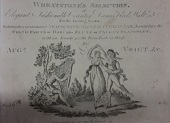
|
The contents are: The Larkin, Susanna Ayers, The Departure, New Sylph, Culver Lodge, Guaracha Dance, The Recovery, Miss Tilney Long's Waltz, Voulez Vous Dancer Mademoiselle, The Tyrolese or New Opera Hat, The Blue Stocking, Morgiana in Portugal, Lord Wellington's Waltz, Julia's Cottage, Fairy Revels, Lady Burdett, Madame Dedelot's Hornpipe, The Regency Waltz, The Tank, The Prussian Waltz.
Note: A copyright dispute involving this work was fought in 1812 involving a tune named The Lady of the Lake. Presumably the tune existed in an earlier edition of this work and was replaced following the dispute for later editions. We've written more on this dispute in another paper.
Full Title: Wheatstone's Selection, of Elegant & Fashionable Country Dances, Reels, Waltz's &c. For the Ensuing Season. Including those much admired Neapolitan & Maltese Pandean Airs, Arranged for the Piano Forte or Harp also Flute or Patent Flageolet, with an Accompt for the Piano Forte or Harp, by Augs Voigt. &c. Book 6th. Price 2s/6
Image © VWML, EFDSS
|
Wheatstone's Selection, of Elegant & Fashionable Country Dances, Reels, Waltz's &c. Book 7th
c.1812 |
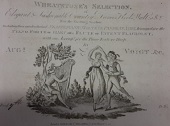
|
The contents are: Mrs Mc Cleod of Rasay's Reel, Phoenix Park, Patrick O Kelly, Lady Charlotte Denny, Salamanca, Mertoun House, The Muses, Dolce Marta, The Regency, Banosse, Kimly Park, The Duke of Leinster, Mozart's Waltz (The Prince Regent's Favorite), St Julian's Cottage, Marchioness of Wellington, La Belle Brunette, Marquiss of Blandford's Waltz, The Maid of Seville, Copenhagen Waltz, Long Live The Prince Regent.
Full Title: Wheatstone's Selection, of Elegant & Fashionable Country Dances, Reels, Waltz's &c. For the Ensuing Season. Including those much admired Neapolitan & Maltese Pandean Airs, Arranged for the Piano Forte or Harp also Flute or Patent Flageolet, with an Accompt for the Piano Forte or Harp, by Augs Voigt. &c. Book 7th. Price 2s/6
Image © VWML, EFDSS
|
Wheatstone's Selection, of Elegant & Fashionable Country Dances, Reels, Waltz's &c. Book 8th
c.1813 |
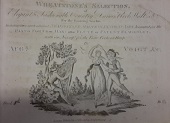
|
The contents are: Enrico (Danced at Vaux hall Fete), Lady Matilda Bruce, Lady Caroline Bertie, The Prince Regent (Danced at his Fete), The Princess of Wales's Waltz, Bateuse, Capn Broke, Silesian Waltz, The Crown Prince, The Maid of Snowden, The Don Cossack Waltz, General Graham, The Isle of Sky (Danced at the Regent's Fete), The Hibernian Legacy, Prince Smolensko, Lady Mildmays Waltz, Lord Delhousie, St Sebastian, The Bohemian Waltz, Miss Platoff.
Full Title: Wheatstone's Selection, of Elegant & Fashionable Country Dances, Reels, Waltz's &c. For the Ensuing Season. Including those much admired Neapolitan & Maltese Pandean Airs, Arranged for the Piano Forte or Harp also Flute or Patent Flageolet, with an Accompt for the Piano Forte or Harp, by Augs Voigt. &c. Book 8th. Price 2s/6
Image © VWML, EFDSS
|
Wheatstone's Selection, of Elegant & Fashionable Country Dances, Reels, Waltz's &c. Book 9th
1814 |
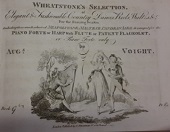
|
The contents are: Saxon Dance, Sicilian Dance (Hatton), Restauration Des Bourbons, Cocarde Blanche, The Sociable, Leipsic Waltz, Bluchers Waltz, Duchess of Oldenburgh's Waltz, Arabella (Waltz), Daphne, Lord St Orville, The Emperor Of Russia's Waltz, The Vienna Waltz, Figaro, General Blucher, Calder Fair, Prince Platoff, Bath Waltz, The Olive Branch (Voigt), The Brighton Bonnet.
Full Title: Wheatstone's Selection, of Elegant & Fashionable Country Dances, Reels, Waltz's &c. For the Ensuing Season. Including those much admired Neapolitan & Maltese Pandean Airs, Arranged for the Piano Forte or Harp with Flute or Patent Flageolet, or Piano Forte only, by Augs Voight. Book 9th. Price 2s/6
Image © VWML, EFDSS
|
Wheatstone's Selection, of Elegant & Fashionable Country Dances, Reels, Waltz's &c. Book 10th
c.1815 |
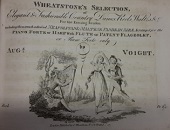
|
The contents are: Bavarian Waltz, Jean de Paris, Vestris's Gavotte (Danced at the Italian Opera), Captain Maitland, The Isle of France, Bombasto Furioso, La Pie Voleuse, Lady Harriet Hoare, The Comet Waltz, La Belle Alliance, Imperial Waltz, Miss O Neil, Frederica, Vienna Waltz, John of Paris, Hibernia, Swiss Dance, Swiss Waltz, Prince Kutosoff, Duke of Anglesea's Waltz.
Full Title: Wheatstone's Selection, of Elegant & Fashionable Country Dances, Reels, Waltz's &c. For the Ensuing Season. Including those much admired Neapolitan & Maltese Pandean Airs, Arranged for the Piano Forte or Harp with Flute or Patent Flageolet, or Piano Forte only, by Augs Voight. Book 10th. Price 2s/6
Image © VWML, EFDSS
|
Wheatstone's Selection, of Elegant & Fashionable Country Dances, Reels, Waltz's &c. Book 11th
1816 |
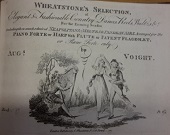
|
The contents are: The Waterloo Dance, The Stop Waltz, La Wellington, The Alexander, La Duc De Berry, Lord of the Isles, The Pavilion, New May Moon, L'Alina, Roxeby or Lady Perth, The Forest of Bondy, Prince L'Lewelln, Madame Lavalette, The Saxe Cobourg Dance, Tripoli Dance, The Villagers, The Royal Nuptials, Meg Merrilies, Duchess of Cumberland, Le Retour de Paris.
Full Title: Wheatstone's Selection, of Elegant & Fashionable Country Dances, Reels, Waltz's &c. For the Ensuing Season. Including those much admired Neapolitan & Maltese Pandean Airs, Arranged for the Piano Forte or Harp with Flute or Patent Flageolet, or Piano Forte only, by Augs Voight. Book 11th. Price 2s/6
Image © VWML, EFDSS
|
Wheatstone's Selection, of Elegant & Fashionable Country Dances, Reels, Waltz's &c. Book 12
c.1817 |
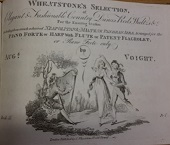
|
The contents are: Capt Wyke (or L'Ete Figure), The Banquet or Don Juan, The Steam Boat or Majestic (Paine), Laura (French Dance), La Flora, Zapeteado, The Sky Lark (J.B. Butler), The Royal Visit to Bath, The Hungarian or Hussar Waltz, The Roxburgh Reel, Lady Sarah Stuart, Wellingtons Triumph, Three Waltzes in One (Danced in Paris), Windsor Park, The Slave Released, Waltz in Don Giovanni, Roxburgh Ball, Sidney House, The Batavian Dance, The Waterloo or National Waltz, Lady John Thynne.
Full Title: Wheatstone's Selection, of Elegant & Fashionable Country Dances, Reels, Waltz's &c. For the Ensuing Season. Including those much admired Neapolitan & Maltese Pandean Airs, Arranged for the Piano Forte or Harp with Flute or Patent Flageolet, or Piano Forte only, by Augs Voight. Book 12. Price 2s/6
Image © VWML, EFDSS
|
Wheatstone's Selection, of Elegant & Fashionable Country Dances, Reels, Waltz's &c. Book 13
c.1818 |
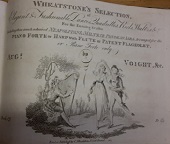
|
The contents are: Marshal's Election (A. Loder), Capt Fotheringham (I.C.H.), Aix La Chapelle, Henrietta (as Danced at Almacks), The Sardinian Dance (C.W.), The Hungarian Waltz, Rob Roy, The Cadiz Dance, Auld Lang Syne, The Triumphant (C.W.), Genl Morrison, The Calypso Dance, Sauteuse, Breslaw Waltz, Bremen Waltz, La Fete Du Village, Modena Waltz, The Belvidere Dance (I.S.), The Leamington Dance (I.S.), Captn Heaviside.
Full Title: Wheatstone's Selection, of Elegant & Fashionable Country Dances, Reels, Waltz's &c. For the Ensuing Season. Including those much admired Neapolitan & Maltese Pandean Airs, Arranged for the Piano Forte or Harp with Flute or Patent Flageolet, or Piano Forte only, by Augs Voight, &c. Book 13. Price 2s/6
Image © VWML, EFDSS
|
An index of the Quadrille Publications issued by Charles Wheatstone
The following table lists the known Wheatstonian Quadrille publications. These works were not issued (as far as is known) in collaboration with Voigt, Wheatstone instead worked with other collaborators.
| Work & Date | Image | Comments |
A Selection of favorite Quadrilles or Fashionable French Dances, Vol 1.
c.1817
(Volume 1) |
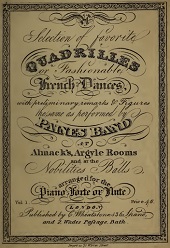
|
This publication consists almost entirely of Quadrille dances published by Edward Payne in (or before) 1816, together with accompanying text. The provenance of the Quadrilles is not identified within the book, but most are readily discernible. We've supplied that provenance information in parentheses after the name of each Quadrille.
The contents are:
La Belle Alliance (Edward Payne's 1816 4th Set),
Le Duc De Wellington (Edward Payne's 1816 4th Set),
Waterloo (Edward Payne's 1816 4th Set),
Le Cuirassier (Edward Payne's 1816 4th Set),
La Belle Gabrielle or Vive Henri IV (Edward Payne's 1816 4th Set),
Le Pantalon (Edward Payne's c.1815 1st Set),
L'Ete (Edward Payne's c.1815 1st Set),
La Finale (Edward Payne's c.1815 1st Set),
La Poule (Edward Payne's c.1815 1st Set),
La Trenise (Edward Payne's c.1815 1st Set),
La Nouvelle Alliance (Edward Payne's 1816 2nd Set, but with figures from his 7th Set),
L'Amaside (Edward Payne's 1816 2nd Set, but with figures from his 7th Set),
L Anonime (Edward Payne's 1816 2nd Set, but with figures from his 7th Set),
La Libertè (Edward Payne's 1816 2nd Set, but with figures from his 7th Set),
La Sephora (Edward Payne's 1816 2nd Set, but with figures from his 7th Set),
Le Duc De Berry (Edward Payne's 1816 3rd Set),
La Caroline (Edward Payne's 1816 3rd Set),
La Leone (Edward Payne's c.1816 3rd Set),
La Henriette (Edward Payne's 1816 3rd Set),
La Finale De Lodoiska (Edward Payne's 1816 3rd Set),
Les Echos (James Paine's c.1816 2nd Set),
La Pastorale (Edward Payne's 1816 2nd Set),
La Nouvelle Pastorale (James Paine's c.1816 4th Set)
Full Title: A Selection of favorite Quadrilles or Fashionable French Dances, with preliminary remarks & Figures the same as performed by Paine's Band at Almack's, Argyle Rooms and at the Nobilities Balls, arranged for the Piano Forte or flute, Vol 1. Price 4/6.
|
A Selection of the favorite Quadrilles or French Dances
c.1817
(Volume 2) |
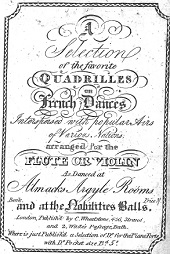
|
This volume differs from the preceding volume in that it lacks dancing figures, and the tunes lack a bass accompaniment. It's therefore a somewhat basic publication, perhaps aimed at musical amateurs. Most of the tunes are arranged to be suitable for dancing Quadrilles from the First Set.
The contents are:
La Richmond (La Poule),
La Francisque (La Trenise),
Le Printems (L'Ete),
Les Thuilleries (La Pantalon),
La Bonne Mere (La Trenise),
La Duroc (La Trenise),
Comme Vous Voudrez (La Poule),
La Fonrina (La Pantalon),
Sauteuse,
St Cmer (La Trenise),
The Forest of Bondy (L'Ete),
La Voluptuese,
La Portefeuille (La Finale),
Bourbon Dance,
Made Lavalette,
Le Delassement,
La Rosa,
Les Nouvielles Graces (L'Ete),
La Wellington,
La Belle Flamande (La Poule),
L'Ete,
La Terpsichore,
La Trenise,
La Maurice,
La Molus (La Poule),
La Retablissement (La Finale),
Restorateur (La Finale),
Le Pantalon Waltz,
L'Ete Waltz,
New Darmstadt Waltz,
La Trenise Waltz,
La Batteuse,
The Spanish Dance,
La Poule,
Zapateado,
Portuguese Air (L'Ete),
La Cachuca,
Cossack Air,
La Cora,
La Finale,
La Liberte (La Trenise),
L'Anonime (La Poule),
La Lisette
Full Title: A Selection of the favorite Quadrilles or French Dances, Interspersed with popular Airs of Various Nations, arranged for the Flute or Violin, as danced at Almacks, Argyle Rooms, and at the Nobilities Balls. Book. Price 3s.
|
A Selection of favorite Quadrilles or Fashionable French Dances, Vol 1.
c.1819
(Volume 3) |
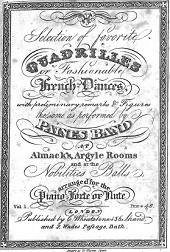
|
This publication has Vol 1 printed on its cover. It nonetheless appears to be the third volume published by Wheatstone in his series. It's similar to Volume 1, and the cover is identical; each Quadrille tune is accompanied with the associated dancing figures (in French), once again with no provenance information. I've been unable to identify any other source for these dances.
The contents are:
La Clarisse,
La Bagatelle,
La Neireide (The water Nymph),
La Pavilion,
Longrice Des Dames,
La Cecile,
La Bath,
La Malvina,
Le Roi Du Bal,
La Colinette,
La St Lucie,
La Cheltenham,
La Laitière,
La Belle Fermière,
La Belle Ninon,
L'Adolphe,
L'Adele,
L'Angelique,
La Laura,
La Petite Thèrese,
La Nouvelle Aline,
L'Eucharys,
Le Printems,
L'Orange,
La Bosse De Buis,
La Mont St Jean,
Le Don Juan,
Le Petit Savoyard,
La Paris,
La Colombe,
Le Hameau,
Marie Therese,
La Polonaise,
L Egyptiene,
La Grele,
La Constance,
La Fantaisie,
La Zoe,
La Chasse
Full Title: A Selection of favorite Quadrilles or Fashionable French Dances, with preliminary remarks & Figures the same as performed by Paine's Band at Almack's, Argyle Rooms and at the Nobilities Balls, arranged for the Piano Forte or flute, Vol 1. Price 4/6.
|
Six Sets of Favorite Quadrilles, by Joseph Collins
c.1820 |

|
This publication appears to have been commissioned by Collins himself, and was merely published through Wheatstone. Collins provided the both the figures and music for each of his Quadrilles; they are:
Set 1: L'Iphigenie, La Pomona, La Terpsichore, La Parthenia, La Lucrece.
Set 2: La Christina, La Tirolienne, La Fete, L'Espèrance, L'Adrien
Set 3: L'Euterpe, La Vistula, La Valencia, La Vesta, La Vertumne
Set 4: L'Amphitrite, L'Ariadne, La Bellerophon, La Bellona, L'Endymion
Set 5: La Luna, La Psyche, La Felicite, La Belle Persienne, La Clio
Set 6: L'Arethuse, La Cleopatre, La Galatée, L'Hyperion, La Thalia
Full Title: Six Sets of Favorite Quadrilles, Composed & Arranged for the Piano Forte, & Respectfully Dedicated to the Rt Honble Countess of Morley, by Joseph Collins, Professor of Music. The Figures by Mons Hamlin.
Image © THE BRITISH LIBRARY BOARD, h.104.(16.) ALL RIGHTS RESERVED
|
Fashionable Parisian Quadrilles, by F. Simonet
c.1822 |

|
The copy of this work that I've studied contains six Quadrille sets, but the associated index lists seven. The contents (including the missing seventh set) are:
Set 1: La Mnemosyne, La Lepine, La Majisteuse, Le Barbier De Seville, La Cleopatre, The Milanese Waltz, La Nouvelle Polonaise, The Cisalpine Waltz
Set 2: La Romulus, La Tayre, La Tisbe, La Thais, L'Aimable Rosette, The Etruscan Waltz, La Cendrillon, The Laybach Waltz
Set 3: L'Annette, L'Hipparchia, La Corinne, La Belle Parisienne, La Rosalinde, Allemande, La Chasse, The Altenburg Waltz
Set 4: La Junon, La Coryphee, La Thalie, La Fanny, La Conquerante, The Verona Waltz, The Pyreneese Waltz, Sateuse
Set 5: La Lucrece, L'Augusta, La Nouvelle Caroline, La Columbia, Sauteuse, The Russian Waltz, La Minerve, La Pastourelle
Set 6: Peter the Hermit, La Victoria, L'Etoile, La Quiroga, L'Adonis, La Pastourelle, The Barcelona Waltz, Waltz from the "Freyschutz"
Set 7: La Comtesse St Antonio, L'Alexandrina, La Minerva, La Zodiaque, La Mina, La Pastourelle, The Echo Waltz
Full Title: Fashionable Parisian Quadrilles, performed by the Bands of Messrs Michau, Musard and Collinet, with their appropriate Figures, as danced at Almack's, the Argyll Rooms, and at the Bath & Cheltenham Assemblies, arranged for the Piano Forte by F. Simonet. Pr 2s.
Image © VWML, EFDSS
|
Quadrilliana
c.1823 |
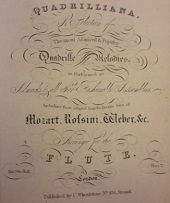
|
This publication contains the music (without bass accompaniment) for many of the popular Quadrilles danced in London. In most case the provenance is readily identifiable, though not acknowledged in the book; we've provided that information in parentheses. No dancing figures are supplied, it might therefore be presumed that this publication was primarily aimed at musical amateurs. The contents (music only) are:
Le Pantalon (Edward Payne's c.1815 1st Set),
L'Ete (Edward Payne's c.1815 1st Set),
La Poule (Edward Payne's c.1815 1st Set),
La Trenise (Edward Payne's c.1815 1st Set),
La Finale (Edward Payne's c.1815 1st Set),
La Nouvelle Pastorale (James Paine's c.1816 4th Set),
La Paysanne (James Paine's c.1816 1st Set),
La Flora (James Paine's c.1816 1st Set),
La Cobourg (James Paine's c.1816 1st Set),
L'Automne,
La Wellington,
La Nouvelle Fantasia (James Paine's 1819 12th Set),
La Lisette (James Paine's 1816 3rd Set),
La Nouvelle Ete (James Paine's c.1816 4th Set),
L'Aline,
Le Garcon Volage (Edward Payne's c.1816 5th Set),
Les Graces (James Paine's 1816 3rd Set),
La Finale de Lodoiska (Edward Payne's c.1816 3rd Set),
Le Dom Juan (Mozart),
La Cendrillon (Carassa),
La Lepine (F. Simonet's c.1821 1st Set),
C'est L'Amour (Joseph Hart's c.1819 2nd Set),
La Native (John Duval's 1817 2nd Set),
La Petit Tambour (Joseph Hart's c.1819 1st Set),
La Leporella,
Le Barbier de Seville (Rossini),
La Rosette (W.H. Steil),
Le Don de Plaire (J. Moralt),
La Virginie,
La Marie,
L' Irlandaise (L.J.),
Le Carnival de Venise (Joseph Hart's c.1819 1st Set),
La Non Chalant (James Paine's c.1816 4th Set),
La Villageoise (James Paine's 1816 3rd Set),
La Terpsichore,
La Nouvelle Polonaise (F. Simonet's c.1821 1st Set),
La Coryphee (F. Simonet's c.1821 4th Set),
La Carillard de Brantignez (James Paine's 1817 7th Set),
La Veritable Chasse (James Paine's c.1816 4th Set),
La Berri (James Paine's 1817 8th Set),
La Junon (F. Simonet's c.1821 4th Set),
Le Petit Montignarde (James Paine's 1817 5th Set),
La Favorite (James Paine's 1817 5th Set),
La Matilda (James Paine's 1816 3rd Set),
Les Deux Amis (Edward Payne's c.1816 5th Set),
La Conquerante (James Paine's 1817 7th Set),
La Serant (James Paine's 1817 8th Set)
Full Title: Quadrilliana, A Selection of the most Admired & Popular Quadrille Melodies, as Performed at Almacks & all other Fashionable Assemblies, including those adapted from the favorite Airs of Mozart, Rossini, Weber, &c. Arranged for the Flute. Price 3s.
Image © THE BRITISH LIBRARY BOARD, e.41.g. ALL RIGHTS RESERVED
|
The music of Wheatstone and Voigt is especially rich, though their figures are less so. Modern Regency dance enthusiasts might like to arrange alternative figures for some of these tunes (the great dancing masters of the 1810s would probably have done so, it's not wrong to make such dances your own!); but we'll leave the investigation here. As always, we'd love to know more, if you have additional information to share, do please Contact Us.
|


 Figure 1. Business card for Wheatstone's Musical Instrument & Music Warehouse, c.1809. Courtesy of the British Museum.
Figure 1. Business card for Wheatstone's Musical Instrument & Music Warehouse, c.1809. Courtesy of the British Museum.
 Figure 2. The location of the Wheatstone business at 436 The Strand, from the Horwood map of 1792-9. © THE BRITISH LIBRARY BOARD, HUS 050.
Figure 2. The location of the Wheatstone business at 436 The Strand, from the Horwood map of 1792-9. © THE BRITISH LIBRARY BOARD, HUS 050.
 Figure 3. A Selection of dance collections with music arranged by Voigt, published in the 1810s by Wheatstone, Preston and Birchall respectively.
Figure 3. A Selection of dance collections with music arranged by Voigt, published in the 1810s by Wheatstone, Preston and Birchall respectively.
 Figure 4. Wheatstone's Elegant & Fashionable collection of 24 Country Dances for the Year 1810 (left), and the c.1809 20th number of Wheatstone's Occasional Repertory of Dances &c. (right). Image © BRITISH LIBRARY BOARD, a.9.jj.(9.) and g.833.k., ALL RIGHTS RESERVED
Figure 4. Wheatstone's Elegant & Fashionable collection of 24 Country Dances for the Year 1810 (left), and the c.1809 20th number of Wheatstone's Occasional Repertory of Dances &c. (right). Image © BRITISH LIBRARY BOARD, a.9.jj.(9.) and g.833.k., ALL RIGHTS RESERVED
 Figure 5. An example Country Dance from Voigt's c.1810 5th Book, featuring a three part musical arrangement. Image © VWML, EFDSS
Figure 5. An example Country Dance from Voigt's c.1810 5th Book, featuring a three part musical arrangement. Image © VWML, EFDSS
 Figure 6. Wheatstone's advertisement for Voigt's Fashionable Dances, 1807. Morning Post, 7th October 1807. Image © THE BRITISH LIBRARY BOARD. ALL RIGHTS RESERVED. Image reproduced with kind permission of The British Newspaper Archive (www.britishnewspaperarchive.co.uk).
Figure 6. Wheatstone's advertisement for Voigt's Fashionable Dances, 1807. Morning Post, 7th October 1807. Image © THE BRITISH LIBRARY BOARD. ALL RIGHTS RESERVED. Image reproduced with kind permission of The British Newspaper Archive (www.britishnewspaperarchive.co.uk).
 Figure 7. Three Waltzes in One, from the c.1817 12th Book. Image © VWML, EFDSS
Figure 7. Three Waltzes in One, from the c.1817 12th Book. Image © VWML, EFDSS
 Figure 8. Advertisements for Voigt's 5th, 9th and 13th books. Above: Morning Post, 25th Jan 1811; Middle: Morning Post, 18th November 1814; Below: Morning Post, 16th February 1819. Images © THE BRITISH LIBRARY BOARD. ALL RIGHTS RESERVED. Images reproduced with kind permission of The British Newspaper Archive (www.britishnewspaperarchive.co.uk).
Figure 8. Advertisements for Voigt's 5th, 9th and 13th books. Above: Morning Post, 25th Jan 1811; Middle: Morning Post, 18th November 1814; Below: Morning Post, 16th February 1819. Images © THE BRITISH LIBRARY BOARD. ALL RIGHTS RESERVED. Images reproduced with kind permission of The British Newspaper Archive (www.britishnewspaperarchive.co.uk).
 Figure 9. Quadrille dancers, from Wheatstone's Quadrilliana, c.1823. Image © BRITISH LIBRARY BOARD, e.41.g., ALL RIGHTS RESERVED
Figure 9. Quadrille dancers, from Wheatstone's Quadrilliana, c.1823. Image © BRITISH LIBRARY BOARD, e.41.g., ALL RIGHTS RESERVED
 Figure 10. Preliminary remarks from two copies of Volume 1; the edition on the left is courtesy of the University of Toronto, the right is from the NYPL.
Figure 10. Preliminary remarks from two copies of Volume 1; the edition on the left is courtesy of the University of Toronto, the right is from the NYPL.
 Figure 11. Payne's Quadrille Instructor (Morning Post, 21st September 1816). Image © THE BRITISH LIBRARY BOARD. ALL RIGHTS RESERVED. Image reproduced with kind permission of The British Newspaper Archive (www.britishnewspaperarchive.co.uk).
Figure 11. Payne's Quadrille Instructor (Morning Post, 21st September 1816). Image © THE BRITISH LIBRARY BOARD. ALL RIGHTS RESERVED. Image reproduced with kind permission of The British Newspaper Archive (www.britishnewspaperarchive.co.uk).
 Figure 12. A Musical Riddle, Morning Post, 19th June 1818. Image © THE BRITISH LIBRARY BOARD. ALL RIGHTS RESERVED. Image reproduced with kind permission of The British Newspaper Archive (www.britishnewspaperarchive.co.uk).
Figure 12. A Musical Riddle, Morning Post, 19th June 1818. Image © THE BRITISH LIBRARY BOARD. ALL RIGHTS RESERVED. Image reproduced with kind permission of The British Newspaper Archive (www.britishnewspaperarchive.co.uk).
 Figure 13. Musical Game, Morning Post, 26th February 1805. Image © THE BRITISH LIBRARY BOARD. ALL RIGHTS RESERVED. Image reproduced with kind permission of The British Newspaper Archive (www.britishnewspaperarchive.co.uk).
Figure 13. Musical Game, Morning Post, 26th February 1805. Image © THE BRITISH LIBRARY BOARD. ALL RIGHTS RESERVED. Image reproduced with kind permission of The British Newspaper Archive (www.britishnewspaperarchive.co.uk).